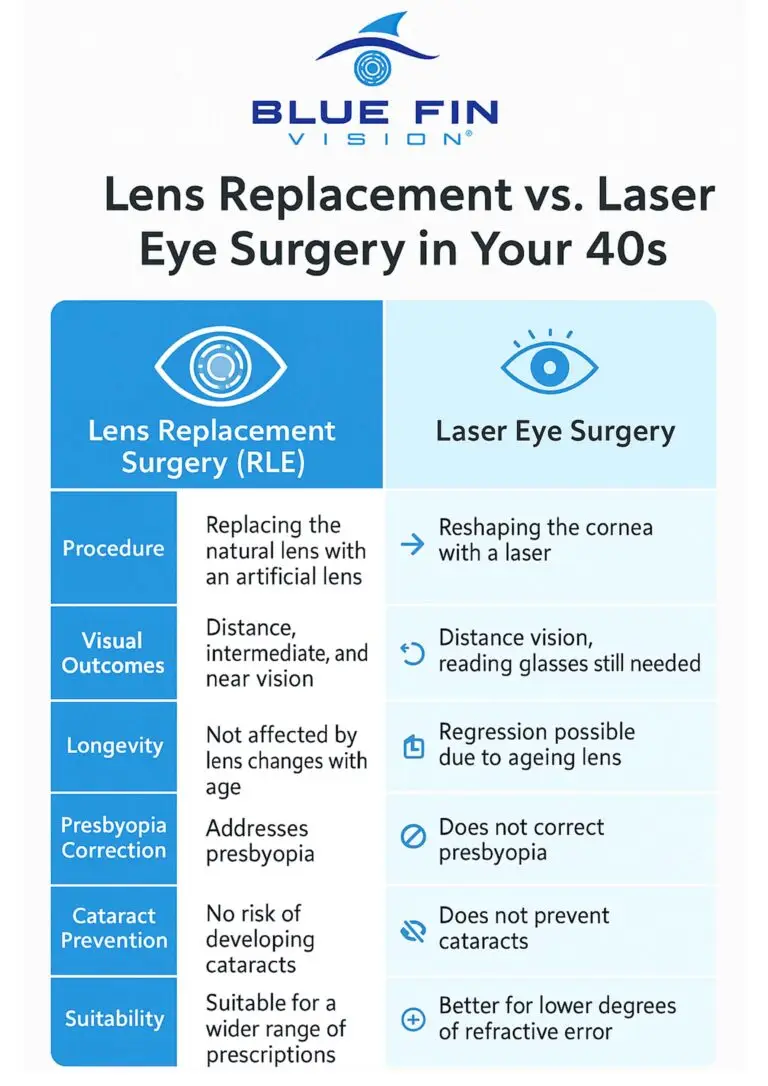
7 Reasons Lens Replacement Surgery Can Outperform Laser Eye Surgery in Your 40s
- Posted
- Medically Reviewed by Mr Mfazo Hove Consultant Ophthalmologist
- Co-author: Chris Dunnington
- Co-author: Mr Mfazo Hove
- Published: August 12, 2025

Infographic: Lens Replacement vs. Laser Eye Surgery in Your 40s
Understanding Presbyopia in Your 40s
Turning 40 often marks the onset of presbyopia – the natural reduction in your eye’s near-focus ability, as the crystalline lens stiffens and the focusing muscle (ciliary body) becomes less effective. While laser eye surgery reshapes the cornea, it does not address the underlying lens. As the lens continues to age, many patients still require reading glasses and are likely to develop cataracts later in life.
Lens Replacement Surgery, also known as Refractive Lens Exchange (RLE), replaces the ageing lens with an advanced intraocular lens (IOL), aiming to restore vision at one or more distances and eliminate the future threat of cataracts. This approach reflects the highest standards of care for vision restoration and long-term eye health. Below, Blue Fin Vision® explains why RLE is often the more comprehensive choice for many individuals in their 40s.
1. Corrects Distance, Intermediate, and Near Vision in One Procedure
- Mechanism: RLE involves removing the natural lens and replacing it with a premium IOL – trifocal, enhanced depth of focus (EDOF), or monofocal with blended targeting. This direct approach at the lens plane tackles presbyopia at its origin.
- Outcome: Addressing presbyopia at its source provides improved performance for near and intermediate tasks, such as reading or working on digital devices, without the compromises associated with monovision correction.
- Astigmatism Correction: Toric IOLs offer the additional benefit of treating regular corneal astigmatism, minimising reliance on glasses across all distances.
2. Prevents Cataracts Before They Start
- Physiology: Cataract refers to the progressive clouding of the crystalline lens. With advancing age, cataract formation is inevitable.
- RLE Advantage: By proactively removing the crystalline lens, RLE eliminates the tissue that would later become cataractous. This means you will not require cataract surgery for that eye in the future.
- Impact: Patients avoid secondary procedures and the visual fluctuations associated with the early stages of cataract formation.
3. Stabilises Vision and Reduces Regression Linked to Lens Ageing
- Laser Limitations: Corneal laser procedures may leave the lens untouched, allowing continued ageing and a shift towards long-sightedness, affecting near vision.
- RLE Stability: Implanted IOLs do not stiffen or yellow with age, maintaining a stable refractive profile long-term, except for minor, natural corneal or axial changes.
- Quality: Removal of a yellowing lens often results in improved contrast sensitivity and colour perception compared with corneal-only laser treatments.
4. Treats Higher Levels of Long-Sightedness (Hyperopia) Safely
- Laser Constraints: High hyperopic corrections with laser require steepening the cornea, risking aberrations and reduced vision quality, as well as limits related to corneal thickness and diameter.
- RLE Benefits: Lens replacement bypasses excessive corneal reshaping, preserving corneal biomechanics and optical quality, particularly in larger corrections.
- Clinical Adaptability: For extreme hyperopia, short axial length, or previously treated corneas, lens-based solutions offer greater predictability and safety.
5. Offers a More Predictable Presbyopia Solution Than Monovision
- Monovision Trade-offs: Some laser strategies use monovision, focusing one eye for distance and the other for near. This can result in compromised depth perception and discomfort.
- Modern IOL Strategy: Trifocal and EDOF lens designs give both eyes functional distance and near vision without noticeable imbalance, supporting better adaptation and daily comfort.
- Customisation: Pre-operative assessment and simulation ensure you are matched to the most suitable lens design, aligned to your lifestyle and visual needs.
6. Access to the Latest Lens Technology and Individualised Selection
- IOL Options: Blue Fin Vision® offers an extensive range, including trifocal, bifocal, EDOF, hybrid multifocal, monofocal-plus, and toric lenses, all tailored to your lifestyle demands – whether prioritising reading, driving at night, digital use, or hobbies.
- Reduced Optical Side-effects: Newer lens profiles and EDOF technology reduce issues such as halos and glare, particularly when coupled with thorough patient selection and ocular surface optimisation.
- Advanced Diagnostics: Precise IOL calculation is informed by state-of-the-art optical biometry and corneal tomography, accounting for posterior corneal astigmatism and effective lens positioning for superior precision.
7. One Procedure with Lifelong Lens Clarity
- Durability: IOLs are engineered for permanence; they do not worsen with age, lose clarity, or require replacement. Post-surgical adjustments are usually minor, such as laser enhancement for residual errors or a straightforward YAG procedure for posterior capsule opacification.
- Efficiency: RLE delivers comprehensive correction and cataract prevention in a single pathway, often reducing the need for repeated eye operations over a patient’s lifetime.
- Value: Considering the future likelihood of cataract surgery and possible laser enhancements, RLE can be the most cost-efficient long-term solution, despite higher initial expenditure.
Risks, Side-effects, and Patient Considerations
- Risks: As with all intraocular procedures, there is a small risk of infection, inflammation, increased eye pressure, retinal detachment (in predisposed eyes), cystoid macular oedema, along with possible visual effects such as halos or glare.
- Fine-Tuning: Some patients may experience minor side-effects that can be addressed with a secondary procedure, including YAG laser capsulotomy or, rarely, piggyback lens implantation.
- Suitability: Not every patient is suitable for every IOL type. Conditions such as dry eye disease, irregular corneas, macular problems, or large pupils may influence lens selection towards monofocal or EDOF designs.
Why Trust Blue Fin Vision® for Your Lens Replacement Surgery?
- Over 50,000 cataract and refractive lens procedures performed with outstanding results.
- Outcomes tracked against National Ophthalmology Database (NOD) benchmarks for quality assurance and transparency.
- More than 521+ verified Doctify reviews, consistently reflecting high satisfaction and patient confidence.
- Collaboration with ZEISS and access to premium intraocular lens platforms, ensuring patients benefit from the latest innovations.
- Comprehensive diagnostics, including advanced biometry, corneal tomography, and ocular surface optimisation, ensuring individualised selection for every IOL.
- Locations in London’s Harley Street and Weymouth Street, Essex (Chelmsford), and Hertfordshire (Hatfield), providing convenient access to expert care.
Begin Your Journey to Lasting Clarity
Experience the power of personalised lens replacement surgery at Blue Fin Vision®. Our team combines world-class medical expertise with a compassionate approach, using advanced diagnostics and technologies to deliver exceptional results. Entrust your vision to our skilled surgeons and discover the confidence that comes with choosing a clinic dedicated to your lifelong eye health.
Book a consultation at Harley Street, London, or one of our other locations, and take the first step towards brighter, clearer vision – guided by professionals fully committed to your care.


